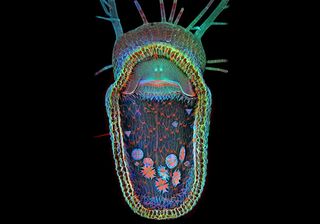Gaping Maw of Aquatic Killer Wins Micro-Photo Competition

The gaping "mouth" of an aquatic killer that sucks in prey just a millisecond after the victims trigger its teensy hairs has been captured in a spellbinding image that has snagged first prize in a micro-photo competition.
Igor Siwanowicz, a neurobiologist at the Howard Hughes Medical Institute's Janelia Farm Research Campus, took the winning image of the floating carnivorous plant, called the humped bladderwort (Utricularia gibba).
That photo beat out more than 2,000 entries from people in 71 countries in the 2013 Olympus BioScapes Digital Imaging Competition. Celebrating its 10th anniversary, the BioScapes competition honors light-microscope images and movies of humans, plants and animals subjects. The winners were announced Sunday night at a gala in New Orleans. [See Stunning Images of Bioscapes Winners]
For his photo, Siwanowicz colored the cells of the bladderwort with the cellulose-binding fluorescent dye Calcofluor and then magnified the subject 100 times using a laser scanning confocal microscope. Highlighted in the image are the single-celled green algae that call the trap home and the trigger hairs sprouting from the center of the bladderwort's dome-shaped trap.
Dorit Hockman, of the United Kingdom's University of Oxford, took second prize for his stereo-microscope photo of the embryo of a black mastiff bat (Molossus rufus). The white embryo, captured during its "peek-a-boo" stage of development when the wings have grown to cover its eyes, looks sort of like a hooded ghost. Third prize and one of several honorable mentions went to Siwanowicz for a composite image of several species of single-celled green alga called desmids, and an image of rotifers (microscopic aquatic animals) surrounding a green alga, respectively.
Other photos in the top 10 included so-called brother bugs (Gonocerus acuteangulatus) at just two hours old, taken by Kurt Wirz of Basel, Switzerland; the head and legs of a caddisfly larva taken by Fabrice Parais of France; and a stained slice of a lily flower bud taken by Spike Walker of Staffordshire, U.K. A video of a single-celled, ciliated creature called a Paramecium snagged 10th place. Ralph Grimm of Queensland, Australia, captured the organism moving through freshwater by contracting its vacuoles (air- or fluid-filled cavities) and sweeping its hairlike cilia back and forth.
"For 10 years, Olympus has sponsored this competition to bring to light the power, beauty and importance of science and the work that scientists do," Brad Burklow, executive director of international business for the scientific equipment group of Olympus America Inc., said in a statement. "BioScapes movies and still images combine art and science to remind us of the fascination and wonder of the natural world and highlight vital work going on in laboratories."
Sign up for the Live Science daily newsletter now
Get the world’s most fascinating discoveries delivered straight to your inbox.
A selection of the winning images and videos will be exhibited in a museum tour, sponsored by Olympus America and Scientific American, hat will travel across the United States this coming year.
Follow Jeanna Bryner on Twitter and Google+. Follow us @livescience, Facebook & Google+. Original article on LiveScience.
Jeanna Bryner is managing editor of Scientific American. Previously she was editor in chief of Live Science and, prior to that, an editor at Scholastic's Science World magazine. Bryner has an English degree from Salisbury University, a master's degree in biogeochemistry and environmental sciences from the University of Maryland and a graduate science journalism degree from New York University. She has worked as a biologist in Florida, where she monitored wetlands and did field surveys for endangered species, including the gorgeous Florida Scrub Jay. She also received an ocean sciences journalism fellowship from the Woods Hole Oceanographic Institution. She is a firm believer that science is for everyone and that just about everything can be viewed through the lens of science.
Most Popular


